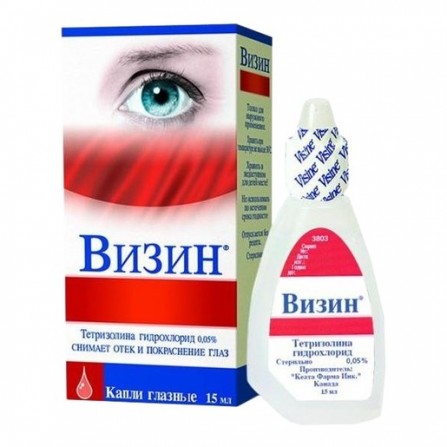Vizin Classic eye drops 15 ml
Condition: New product
1000 Items
Rating:
Be the first to write a review!

More info
Active ingredients
Tetrizolin
Release form
Drops
Composition
On 1 ml: tetrizolina hydrochloride 500 mcg. Excipients: boric acid, sodium chloride, disodium edetate, benzalkonium chloride solution 17%, sodium borate, purified water.
Pharmacological effect
Alpha adrenomimetic. Tetrizoline stimulates the α-adrenoreceptors of the sympathetic nervous system, does not have or has a weak effect on β-adrenoreceptors. It has a vasoconstrictor effect and reduces tissue swelling. The action of the drug begins 60 seconds after instillation and lasts 4-8 hours.
Pharmacokinetics
Tetrizoline is practically not absorbed when applied topically. Detailed pharmacokinetic studies with the use of eye drops have not been conducted.
Indications
- swelling and hyperemia of the conjunctiva, caused by allergies or caused by exposure to chemical and physical factors (smoke, dust, chlorinated water, light, cosmetics, contact lenses).
Contraindications
- endothelial epithelial dystrophy of the cornea; - angle-closure glaucoma; - children's age up to 2 years; - hypersensitivity to the components of the preparation.
Precautionary measures
The drug should be used with caution in severe cardiovascular diseases (eg, ischemic heart disease, arterial hypertension, arrhythmias, aneurysm), hyperthyroidism, diabetes mellitus, pheochromocytoma, and in patients receiving MAO inhibitors or other means that can increase blood pressure.
Use during pregnancy and lactation
Given the risk of developing systemic adverse reactions, the use of the drug during pregnancy and lactation (breastfeeding) is possible only in cases where the intended benefit of therapy for the mother outweighs the potential risk to the fetus or infant.
Dosage and administration
Instill 1-2 drops in the affected eye 2-3 times / day. It is not recommended that the drug be used continuously for more than 4 days. When instilled, it is necessary to remove the cap from the dropper bottle and turn the bottle upside down. It is necessary to avoid touching the tip of the dropper to any surfaces. Application should be screwed cap dropper.
Side effects
On the part of the organ of vision: in rare cases - burning sensation, redness of the eye, pain and tingling in the eye, blurred vision, irritation of the conjunctiva, pupil dilation. The patient should be warned that if any adverse reactions develop, one should immediately consult a doctor.
Overdose
When using the drug in accordance with the instructions, the risk of overdose is minimal. However, if the drug enters the gastrointestinal tract, the following symptoms are possible: dilated pupil, nausea, cyanosis, fever, convulsions, tachycardia, arrhythmia, cardiac arrest, hypertension, pulmonary edema, impaired respiratory function, central nervous system function, coma. The risk of overdose symptoms associated with absorption of the drug is high in newborns and young children, especially when the drops are swallowed. Treatment: if necessary, activated charcoal, gastric lavage, oxygen inhalation, antipyretic and anticonvulsant funds To reduce blood pressure, it is possible to / in the slow introduction of 5 mg of phentolamine in physiological saline or ingestion of phentolamine at a dose of 100 mg. For patients with low blood pressure, vasopressor agents are contraindicated. The specific antidote is unknown.
Interaction with other drugs
Drug interaction of the drug has not been studied.
special instructions
Before instillation of the drug, you must remove the contact lenses and install them about 15 minutes after instillation. The drug should be used only with mild eye irritation. The patient should be warned that if the condition does not improve within 48 hours or the irritation and hyperemia persist or increase, the drug should be withdrawn and consult a doctor. The patient should be informed that if there is intense eye pain, headache, loss of vision , the sudden appearance of floating spots before the eyes, with reddening of the eyes, pain when exposed to light or when double vision appears in the eyes, you should immediately consult a doctor. Do not use the drug if irritation or hyperemia is due s body with serious diseases of view, such as an infection, a foreign body or chemical injury rogovitsy.Patsient should be informed that if the drug became useless or expiration date, you should not throw it in the waste water or the street. It is necessary to put the drug in the bag and put it in the trash. These measures will help to protect the environment. Impact on the ability to drive vehicles and control mechanisms In rare cases, after applying eye drops, pupil dilation is observed and blurred vision occurs, which can affect the ability to drive a car or machinery.


